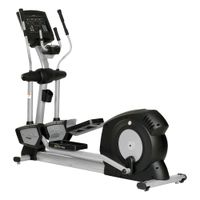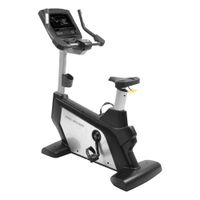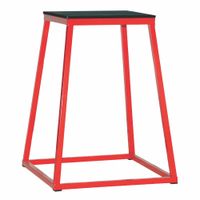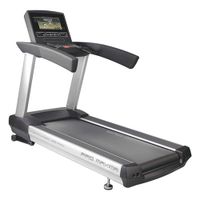Call +(254) 703 030 000 / 751 483 999 / 721 704 777
.....Read More
Frequently Asked Questions
What are the benefits of using cardio equipment for heart health?
Using cardio equipment offers several benefits for heart health:
1. **Improved Cardiovascular Efficiency**: Regular use of cardio equipment like treadmills, ellipticals, and stationary bikes enhances the heart's ability to pump blood efficiently, reducing the heart rate over time and improving overall cardiovascular function.
2. **Lower Blood Pressure**: Engaging in consistent cardiovascular exercise helps lower both systolic and diastolic blood pressure, reducing the strain on the heart and decreasing the risk of hypertension.
3. **Cholesterol Management**: Cardio workouts can increase levels of high-density lipoprotein (HDL) cholesterol, the "good" cholesterol, while lowering low-density lipoprotein (LDL) cholesterol, the "bad" cholesterol, thus promoting better heart health.
4. **Weight Management**: Cardio equipment aids in burning calories and reducing body fat, which is crucial for maintaining a healthy weight. This, in turn, decreases the risk of heart disease associated with obesity.
5. **Improved Circulation**: Regular cardiovascular exercise enhances blood flow, ensuring that oxygen and nutrients are efficiently delivered to tissues and organs, including the heart.
6. **Reduced Risk of Heart Disease**: Consistent use of cardio equipment can lower the risk of developing heart disease by improving heart function, reducing risk factors like high blood pressure and cholesterol, and promoting overall cardiovascular health.
7. **Stress Reduction**: Cardio exercise releases endorphins, which help reduce stress and anxiety levels. Lower stress levels contribute to better heart health by reducing the risk of stress-related heart issues.
8. **Enhanced Endurance and Stamina**: Regular cardio workouts increase endurance and stamina, allowing the heart to work more efficiently during both exercise and daily activities.
9. **Blood Sugar Control**: Cardiovascular exercise helps regulate blood sugar levels, reducing the risk of type 2 diabetes, which is a risk factor for heart disease.
How does a treadmill improve cardiovascular fitness?
A treadmill improves cardiovascular fitness by providing a controlled environment for aerobic exercise, which strengthens the heart and enhances the efficiency of the cardiovascular system. When you walk, jog, or run on a treadmill, your heart rate increases, promoting better circulation and oxygen delivery to muscles. This consistent aerobic activity helps lower blood pressure, improve cholesterol levels, and increase lung capacity.
The treadmill allows for adjustable speed and incline, enabling users to tailor workouts to their fitness levels and gradually increase intensity. This progressive overload challenges the heart and lungs, leading to improved endurance and stamina. Regular treadmill workouts enhance the heart's ability to pump blood more efficiently, reducing the resting heart rate over time.
Moreover, treadmill exercise stimulates the production of endorphins, which can reduce stress and improve mood, indirectly benefiting cardiovascular health. The convenience of indoor exercise on a treadmill ensures consistent workouts regardless of weather conditions, promoting adherence to a regular exercise routine.
In summary, treadmill workouts enhance cardiovascular fitness by improving heart and lung function, increasing endurance, and promoting overall heart health through consistent, adaptable aerobic exercise.
What is the difference between an elliptical and a step machine?
An elliptical machine and a step machine are both popular cardiovascular exercise equipment, but they differ in design, movement, and benefits.
An elliptical machine features foot pedals and handles, allowing for a full-body workout. The pedals move in an elliptical, or oval, motion, which mimics walking, running, or stair climbing without the high impact on joints. This low-impact nature makes it suitable for individuals with joint issues or those seeking a gentler workout. The elliptical also engages both the upper and lower body, as users can push and pull the handles while pedaling, providing a comprehensive cardiovascular workout that can improve endurance and burn calories efficiently.
In contrast, a step machine, often referred to as a stair stepper or stair climber, simulates the action of climbing stairs. It primarily targets the lower body, including the glutes, quadriceps, hamstrings, and calves. The movement is more vertical compared to the elliptical's horizontal glide, which can lead to a more intense workout for the legs and buttocks. Step machines can vary in design, with some offering independent foot pedals and others featuring a continuous belt that mimics an escalator. While step machines provide a higher-impact workout than ellipticals, they are effective for building lower body strength and improving cardiovascular fitness.
In summary, the elliptical offers a low-impact, full-body workout suitable for a wide range of fitness levels, while the step machine provides a more intense, lower-body-focused exercise. The choice between the two depends on individual fitness goals, joint health, and personal preference.
Are exercise bikes effective for low-impact cardio workouts?
Yes, exercise bikes are effective for low-impact cardio workouts. They provide a cardiovascular workout that increases heart rate and improves cardiovascular health without putting excessive stress on the joints. This makes them ideal for individuals with joint issues, arthritis, or those recovering from injuries.
Exercise bikes offer adjustable resistance levels, allowing users to tailor the intensity of their workouts to match their fitness levels and goals. This adaptability makes them suitable for beginners and advanced users alike. The seated position on a stationary bike reduces the risk of injury and provides stability, making it a safe option for older adults or those with balance concerns.
Additionally, exercise bikes engage major muscle groups, including the quadriceps, hamstrings, calves, and glutes, promoting muscle endurance and strength. They also help in burning calories, aiding in weight management and fat loss.
The convenience of using an exercise bike at home or in a gym setting allows for consistent workouts regardless of weather conditions, contributing to regular exercise habits. Many modern exercise bikes come equipped with features like heart rate monitors, pre-programmed workouts, and digital displays to track progress, enhancing the workout experience.
Overall, exercise bikes are a versatile and effective tool for low-impact cardio workouts, offering numerous health benefits while minimizing the risk of injury.
How do plyo training boxes enhance cardiovascular health?
Plyometric training boxes enhance cardiovascular health by providing a high-intensity workout that elevates heart rate and improves cardiovascular endurance. When performing exercises like box jumps, the rapid and explosive movements require significant energy expenditure, which increases heart rate and promotes better circulation. This type of training engages multiple muscle groups simultaneously, leading to improved oxygen uptake and utilization, which are key components of cardiovascular fitness.
The repetitive nature of plyometric exercises on training boxes also contributes to increased stamina and endurance. As the body adapts to the demands of these exercises, the heart becomes more efficient at pumping blood, and the lungs become more effective at oxygen exchange. This results in a lower resting heart rate and improved recovery times, both indicators of enhanced cardiovascular health.
Additionally, plyometric training can lead to improved metabolic rate, which helps in burning calories and reducing body fat. Lower body fat percentage is associated with reduced risk of cardiovascular diseases. The high-intensity nature of plyometric exercises also stimulates the production of beneficial hormones like adrenaline and endorphins, which can improve mood and reduce stress, further supporting heart health.
Moreover, plyometric training boxes can be adjusted in height, allowing for progressive overload, which is essential for continuous cardiovascular improvement. As individuals become more proficient, they can increase the intensity by using higher boxes or incorporating more complex movements, ensuring ongoing cardiovascular benefits.
In summary, plyometric training boxes enhance cardiovascular health by increasing heart rate, improving oxygen utilization, boosting endurance, reducing body fat, and promoting efficient heart and lung function, all of which contribute to a healthier cardiovascular system.
What are the advantages of using training hurdles for cardio exercise?
Training hurdles offer several advantages for cardio exercise:
1. **Improved Agility and Coordination**: Hurdles require quick footwork and precise movements, enhancing agility and coordination. This is beneficial for athletes in sports requiring rapid directional changes.
2. **Enhanced Cardiovascular Fitness**: Jumping over hurdles elevates the heart rate, providing an effective cardiovascular workout that improves heart and lung capacity.
3. **Increased Muscle Strength and Endurance**: The act of jumping engages multiple muscle groups, including the legs, core, and arms, building strength and endurance over time.
4. **Better Balance and Stability**: Navigating hurdles requires maintaining balance and stability, which strengthens the core and improves overall body control.
5. **Versatility in Training**: Hurdles can be used in various drills and routines, making them a versatile tool for different fitness levels and goals.
6. **Enhanced Speed and Power**: Regular hurdle training can increase explosive power and speed, beneficial for sprinters and athletes in power-based sports.
7. **Weight Loss and Calorie Burn**: The high-intensity nature of hurdle exercises can lead to significant calorie burn, aiding in weight loss and fat reduction.
8. **Mental Focus and Concentration**: Successfully clearing hurdles requires concentration and mental focus, which can improve cognitive function and mental resilience.
9. **Low Equipment Cost**: Hurdles are relatively inexpensive and can be used in various settings, making them accessible for personal and group training.
10. **Injury Prevention**: By improving strength, flexibility, and coordination, hurdle training can help prevent injuries related to falls or missteps in sports and daily activities.
Which cardio equipment is best for improving circulatory system health?
Treadmills are often considered the best cardio equipment for improving circulatory system health. They provide a versatile and effective cardiovascular workout that can be tailored to various fitness levels. Walking or running on a treadmill increases heart rate, enhances blood circulation, and strengthens the heart muscle, which is crucial for circulatory health. The ability to adjust speed and incline allows users to progressively challenge their cardiovascular system, promoting endurance and heart efficiency.
Elliptical trainers are another excellent option, offering a low-impact workout that minimizes joint stress while still providing a robust cardiovascular challenge. They engage both the upper and lower body, increasing heart rate and improving circulation.
Stationary bikes, including upright and recumbent models, are also beneficial for circulatory health. They provide a low-impact workout that is gentle on the joints, making them suitable for individuals with joint issues. Cycling enhances heart rate and circulation, and the resistance levels can be adjusted to increase cardiovascular intensity.
Rowing machines offer a full-body workout that significantly boosts cardiovascular health. They engage multiple muscle groups, increasing heart rate and improving blood flow. The combination of strength and cardio training on a rowing machine can enhance overall circulatory efficiency.
Ultimately, the best cardio equipment for improving circulatory system health depends on individual preferences, fitness levels, and any existing health conditions. Consistency and intensity of the workout are key factors in achieving optimal circulatory health benefits.



